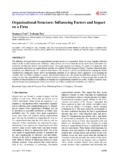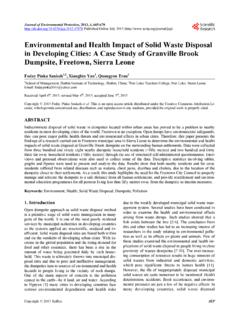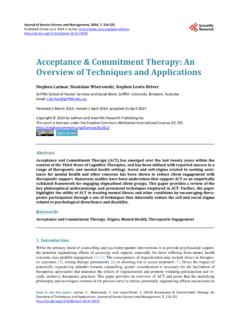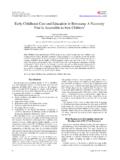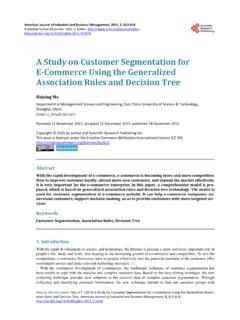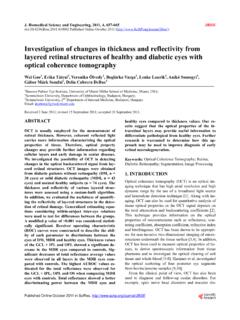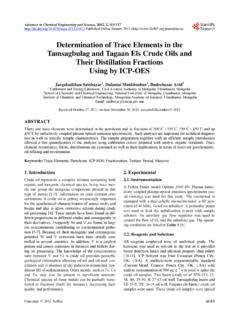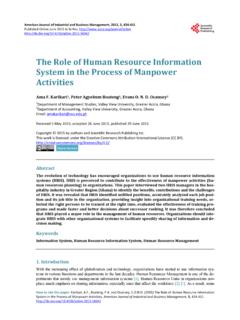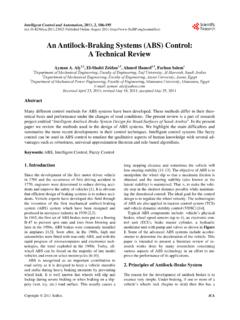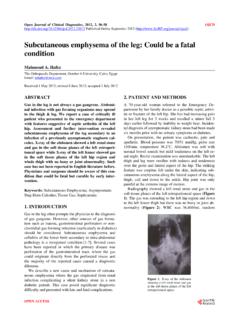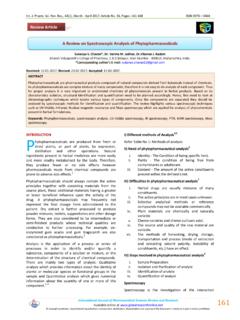Transcription of Phenylpropanoids as the biologically active …
1 Advances in Biological Chemistry, 2013, 3, 26-28 ABC Published Online February 2013 ( ) Phenylpropanoids as the biologically active compounds of the medicinal plants and phytopharmaceuticals Vladimir A. Kurkin Department of Pharmacognosy, Samara State Medical University, Samara, Russia Email: Received 1 January 2013; revised 1 February 2013; accepted 7 February 2013 ABSTRACT In the present paper are discussed the results of the investigations of the Phenylpropanoids of the medici- nal plants which are of the great interest as the sources of the neurotropic, adaptogenic, immunostimulating, antioxidative, and hepatoprotective preparations.
2 There were shown the necessity of using of the stan- dard samples of triandrin (Rhodiola rosea L. tissue cultures, Salix viminalis L. barks), rosavin (Rhodiola rosea L. rhizomes), syringin, or eleutheroside B [Eleu- therococcus senticosus (Rupr. et Maxim.) Maxim. rhizomes, Syringa vulgaris L. barks], and silybin [Silybum marianum (L.) Gaertn. fruits] for purpose of the standardization of the corresponding drugs and pharmaceuticals. It was shown also the significance of -schizandrin, chicoric acid, rosmarinic acid and la- vandoside for purposes of the standardization of raw material and preparations of Schizandra chinensis Baill.
3 Fruits and seeds, Echinacea purpurea (L.) Moench. herbs, Melissa officinalis L. herbs and La- vandula spica L. flowers respectively. Keywords: Phenylpropanoids ; Medicinal Plants; phytopharmaceuticals ; Standardization; Neurotropic; Adaptogenic; Hepatoprotective; Antioxidative; Immunomodulating Activities 1. INTRODUCTION The Phenylpropanoids are biologically active compounds of medicinal plants which are perspective sources of the neurotropic, adaptogenic, immunostimulating, and heap- toprotective preparations [1-8]. The greatest interest are glycosides of cinnamic alcohol, p-coumaric alcohol, sinapic alcohol of Salix viminalis L.
4 Barks (1), Rhodiola rosea L. tissue cultures (1), Rhodiola rosea L. rhizomes (2), Eleutherococcus senticosus (Rupr. et Maxim.) Maxim. rhizomes (3), Syringa vulgaris L. barks (3), and also flavolignan silybin (4) on the base of coniferyl al- cohol and flavonoid taxifolin of Silybum marianum (L.) Gaertn. fruits. In addition, from the point of view of standardization deserve the attention of the caffeic acid and ferulic acid and their derivatives, namely chicoric acid (7), rosmarinic acid (8), and lavandoside (6), a new plant compounds, which have the chemical structure of 4-0- -D-glucopyranoside of ferulic acid.
5 Previously, we have been isolated a series of Phenylpropanoids , in- cluding new biologically active compounds [5,9], but in comparative aspects they have not been studied from the point of view the physical-chemical, spectral and phar- macological properties especially in terms of approaches to standardization and development of new drugs. More- over, still in the references, in particular in the field of pharmacognosy, in the not yet fully formed an opinion in relation to Phenylpropanoids as a special group of bio- logically active compounds. The purpose of our work is the comparative study of the physical-chemical, spectral and pharmacological pro- perties of Phenylpropanoids as biologically active diag- nostic significant compounds of the pharmacopeia me- dicinal plants and phytopharmaceuticals , which are using in Russian Federation.
6 2. PLANT MATERIAL AND METHODS Plant Material For our experiments we collected the plant materials of Rhodiola rosea (rhizomes), Syringa vulgaris (barks), Silybum marianum (fruits), Echinacea purpurea (L.) Moench. (herbs), Melissa officinalis L. (herbs) and La- vandula spica L. (flowers) cultivated in Samara region. The some drugs were collected from widely distributed plants in Samara region (Salix viminalis barks) or in Khabarovsk Krai (Eleutherococcus senticosus rhizomes, Schizandra chinensis Baill. fruits and seeds). There was studied also the biomass of Rhodiola rosea L. tissue cul- tures. Methods The isolation of Phenylpropanoids (1-8) (Figure 1) from OPEN ACCESS V.
7 A. Kurkin / Advances in Biological Chemistry 3 (2013) 26-28 27 OOHHOHOOHOH O OOOOOHHOHOOHOHHO Triandrin (1) Rosavin (2) OCH3 HOOOCH3 Glc OHOOOOHOOHCH2 OHOCH3OH Syringin (Eleutheroside В) (3) Silybin (4) OOCH3 OCH3 CH3 H3OH3OH3 OCCC HOOHOOHCOOH OCH3 OHO -Schizandrin (5) Lavandoside (6) OHOHOOCCOOHHCCOOHOHOOHOH OHOHOOCOOHOHOH Chicoric acid (7) Rosmarinic acid (8) Figure 1. The chemical structures of Phenylpropanoids of investigated plants.
8 The plant material there was carried out by means of ex- traction with 70% ethanol. The separation of isolated compounds there was development with the using of column chromatography on the silica gel L 40/100 and (or) polyamide ( Woelm ). As the eluents we have been used the several solvents (chloroform, 96% ethanol, wa- ter etc.) and their mixtures. The structural elucidation of the isolated phenylpro- panoids (1-8) was carried out by means of the UV-, 1H-NMR-spectroscopy, mass spectrometry and several chemical transformations (acetylation, methylation, acid hydrolysis and enzymatic hydrolysis). Methods of identi- fication of the herbal material and preparations of men- tioned plants were developed with the use of UV-spec- troscopy TLC and HPLC.
9 Proton NMR experiments were performed using spec- trometer Bruker AM 300 (300 MHz). UV spectra there were registered on spectrophotometer Specord 40 (Analytik Jena). Mass spectra of compounds there were determined by means of the spectrometer Kratos MS-3 . TLC-analysis was carried out by means of the plates Sorbfil (solvent system: chloroform:ethanol, 9:1; chlo- roform:methanol:water, 26:14:3; n-butanol:glacial acetic acid:water, 4:1:2). HPLC-analysis was carried out by means of chromatograph Milichrom-6 (Russia) with the using of the stationary reversed phase Diasorb C-16 , gradient or isocratic conditions (mobile phase: the mixtures of acetonitrile and water with the addition of 1% of glacial acetic acid).
10 3. RESULTS AND DISCUSSION In the course of our investigations there were studied the Phenylpropanoids of the medicinal plants which are of the great interest as the sources of the tonic, adaptogenic, sedative, anxiolitic, immunostimulating, antioxidative and hepatoprotective preparations. There were motivated the using of the standard samples of triandrin (1) (Rho- diola rosea L. tissue cultures, S. viminalis barks), rosavin (2) (Rhodiola rosea L. rhizomes), syringin (3) [Eleu- Copyright 2013 SciRes. OPEN ACCESS V. A. Kurkin / Advances in Biological Chemistry 3 (2013) 26-28 28 therococcus senticosus (Rupr.)]
